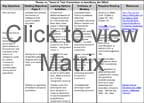Weekly Objectives
In this week you will...
- investigate a variety of gifted program delivery models.
- explain how a student’s level of need helps to determine his placement in an educational program.
- analyze the practice of ability grouping to determine its appropriate use for gifted programming.
- examine a variety of curriculum differentiation techniques that can be used to meet the needs of gifted students.
- compare and contrast how the gifted classroom differs from the regular education classroom in regards to curriculum, instruction, assessment, conceptual orientation, grouping, and environment.
Program Models and Curricular Options
Flexible ability grouping, when used appropriately, works. According to a 2010 meta-analysis by Kelly Puzio and Glenn Colby, students who were grouped by ability within a class for reading were able to make up to an additional “half of a year’s growth in reading.” Similarly, a 2013 National Bureau of Economic Research study of students who were grouped by ability found that the performance of both high and low performing students significantly improved in math and reading, demonstrating the universal utility of this tool, particularly as our classrooms become more academically diverse.
For years, ability grouping has been unduly criticized and misconstrued. Contrary to what some may say, flexible ability grouping is not tracking, which typically sets a far more rigid and defined path for a student to traverse and where breaking out of one track and into another often requires the skills of Harry Houdini.
Flexible ability grouping could not be more different. When used properly, ability grouping does not affix permanent labels to students and does not prevent students from moving—either up or down—during their educational careers. Rather, flexible ability grouping is a tool used to match a student’s readiness for learning with the instruction provided, delivering the right content to the right student at the right pace and at the right time.
By Paula Olszewski-Kubilius
Gifted Education Programming
You have spent the last four weeks discovering and identifying gifted students. You have learned that they have unique needs, they have rights that are guaranteed by the federal government, and they are entitled to special services. According to the National Association for Gifted Children, “The development of appropriate gifted education programming requires comprehensive services based on sound philosophical, theoretical, and empirical support.”
For more information, visit Gifted Education Programming Criterion: Program Design (Table 3 of 7) from NAGC.
How does your school/school district measure up? Do you have a standardized program that is the same in all schools? Do you have gifted clusters or magnets in some schools and the children who qualify are bused when the program meets or attend full time instead of going to their home school? Do your students participate in a full time self-contained program or are they in a part time resource program? If the program is part time is it curriculum based or enrichment based? The questions go on and on.
This week we are going to examine the governmentally mandated requirements, some different types of program models, and what is offered to gifted students in your home district. We will also investigate a variety of differentiation strategies that can be used to help meet students' individual needs.

